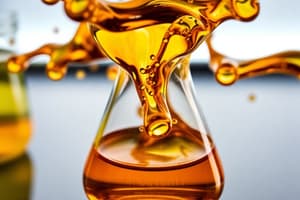Podcast
Questions and Answers
What is the inlet pressure of the steam entering the turbine?
What is the inlet pressure of the steam entering the turbine?
- 1.4 MPa
- 0.5 MPa
- 450°C
- 5 MPa (correct)
Which assumption is NOT a part of the analysis of the turbine process?
Which assumption is NOT a part of the analysis of the turbine process?
- Kinetic and potential energies are negligible.
- There is no heat transfer.
- The process is adiabatic.
- The process is irreversible. (correct)
What is the outlet pressure of the steam after passing through the turbine?
What is the outlet pressure of the steam after passing through the turbine?
- 5 MPa
- 0.1 MPa
- 1.4 MPa (correct)
- 2.5 MPa
Which of the following is a characteristic of the turbine's operational process?
Which of the following is a characteristic of the turbine's operational process?
What indicates that the turbine process can be considered reversible?
What indicates that the turbine process can be considered reversible?
What is the primary output measured for the turbine's operation?
What is the primary output measured for the turbine's operation?
What does the differential form of the conservation of energy equation represent for a closed stationary system?
What does the differential form of the conservation of energy equation represent for a closed stationary system?
Which equation is referred to as the first T ds equation or Gibbs equation?
Which equation is referred to as the first T ds equation or Gibbs equation?
Which type of work interaction is considered in the Gibbs equation for a simple compressible system?
Which type of work interaction is considered in the Gibbs equation for a simple compressible system?
What does the equation h = u + Pv represent?
What does the equation h = u + Pv represent?
How is the second T ds equation derived?
How is the second T ds equation derived?
In the context of an internally reversible process, what does dQ int rev equal to?
In the context of an internally reversible process, what does dQ int rev equal to?
What is represented by the symbol 'v' in the equation T ds = dh - v dP?
What is represented by the symbol 'v' in the equation T ds = dh - v dP?
Which property change does the Gibbs equation explicitly relate to entropy changes?
Which property change does the Gibbs equation explicitly relate to entropy changes?
What is the change in entropy for the source when 2000 kJ of heat is transferred at 800 K?
What is the change in entropy for the source when 2000 kJ of heat is transferred at 800 K?
What is the change in entropy for the sink when 2000 kJ of heat is absorbed at 500 K?
What is the change in entropy for the sink when 2000 kJ of heat is absorbed at 500 K?
What is the total entropy generated during the heat transfer process to the 500 K sink?
What is the total entropy generated during the heat transfer process to the 500 K sink?
Which condition leads to a smaller total entropy change in the second part of the calculation?
Which condition leads to a smaller total entropy change in the second part of the calculation?
In the context of the processes described, what is the effect of using a Carnot heat engine?
In the context of the processes described, what is the effect of using a Carnot heat engine?
How can the entropy change of a substance be expressed?
How can the entropy change of a substance be expressed?
What characterizes the entropy changes measured for the reservoirs in the described process?
What characterizes the entropy changes measured for the reservoirs in the described process?
What does the entropy value of a system depend on?
What does the entropy value of a system depend on?
What determines the power output of a turbine?
What determines the power output of a turbine?
What is the relationship between Ein and Eout for a steady-state turbine?
What is the relationship between Ein and Eout for a steady-state turbine?
What is the formula used to calculate the work output of a turbine?
What is the formula used to calculate the work output of a turbine?
What property is NOT provided at the final state of the turbine process?
What property is NOT provided at the final state of the turbine process?
What additional condition is required to find the second property at the final state?
What additional condition is required to find the second property at the final state?
What assumption about energy transfer is made for the turbine described?
What assumption about energy transfer is made for the turbine described?
Which energy forms are considered in the energy balance for the turbine?
Which energy forms are considered in the energy balance for the turbine?
What is implied by the term isentropic in the context of the turbine process?
What is implied by the term isentropic in the context of the turbine process?
What characterizes organized or low-entropy learning?
What characterizes organized or low-entropy learning?
What happens when students do not secure information properly?
What happens when students do not secure information properly?
How can a library be compared to organized learning?
How can a library be compared to organized learning?
What is the relationship between entropy and library organization?
What is the relationship between entropy and library organization?
Which library scenario illustrates high entropy?
Which library scenario illustrates high entropy?
Why is a poorly organized library likened to high entropy?
Why is a poorly organized library likened to high entropy?
How do some students mistakenly believe they are learning?
How do some students mistakenly believe they are learning?
What would typically happen in a high-entropy environment during a retrieval task?
What would typically happen in a high-entropy environment during a retrieval task?
Flashcards are hidden until you start studying
Study Notes
Entropy Change Calculation
- Entropy change for reservoirs can be computed during reversible isothermal processes.
- For a heat transfer process to a sink at 500 K, the source loses 2000 kJ, resulting in:
- (\Delta S_{source} = -2.5 \text{ kJ/K}) (at 800 K)
- (\Delta S_{sink} = +4.0 \text{ kJ/K}) (at 500 K)
- Net entropy generation during the process is +1.5 kJ/K, indicating irreversibility occurs in the partition.
- Repeating for a sink at 750 K yields:
- (\Delta S_{source} = -2.5 \text{ kJ/K})
- Total entropy change becomes 0.2 kJ/K, indicating a less irreversible process due to a smaller temperature difference.
Carnot Heat Engine Context
- Irreversibilities can be eliminated by using a Carnot heat engine, where total entropy change (\Delta S_{total} = 0).
Entropy Change of Pure Substances
- Entropy is a fixed property determined by the state of a simple compressible system, which can be established by two independent intensive properties.
- The change in entropy ((s_2 - s_1)) can be expressed through other thermodynamic properties.
Adiabatic Turbine Analysis
- Steam enters a turbine at 5 MPa and 450 °C and exits at 1.4 MPa.
- The analysis assumes:
- Steady-flow process with no time variation (ΔmCV = 0, ΔECV = 0, ΔSCV = 0).
- Process is reversible and adiabatic with no heat transfer.
- Work output is determined using the energy balance equation:
- (\text{Ein} - \text{Eout} = \frac{dE_{system}}{dt} = 0).
- Therefore, net energy transfer equals: (m(h_1 - h_2) = W_{out}).
- The process requires both pressure and one additional property for complete specification.
Learning and Organization Analogy
- Effective learning is compared to low-entropy organization: well-structured information is easier to retrieve.
- A high-entropy scenario, like disorganized books, hampers information retrieval during tests.
Gibbs Equation
- The conservation of energy for a closed system undergoing internally reversible processes is given by: [dQ_{int , rev} - dW_{int , rev, out} = dU.]
- Relating heat and work:
- (dQ_{int , rev} = T dS) and (dW_{int , rev, out} = P dV).
- This leads to the Gibbs equation: [T dS = dU + P dV]
- Only boundary work is notable for simple compressible systems during reversible processes.
Enthalpy Relationship
- The second T ds equation is expressed using the definition of enthalpy (h = u + Pv):
- (\int T ds = dh - v dP).
- Both equations are significant for relating changes in entropy to alterations in other thermodynamic properties.
Studying That Suits You
Use AI to generate personalized quizzes and flashcards to suit your learning preferences.




